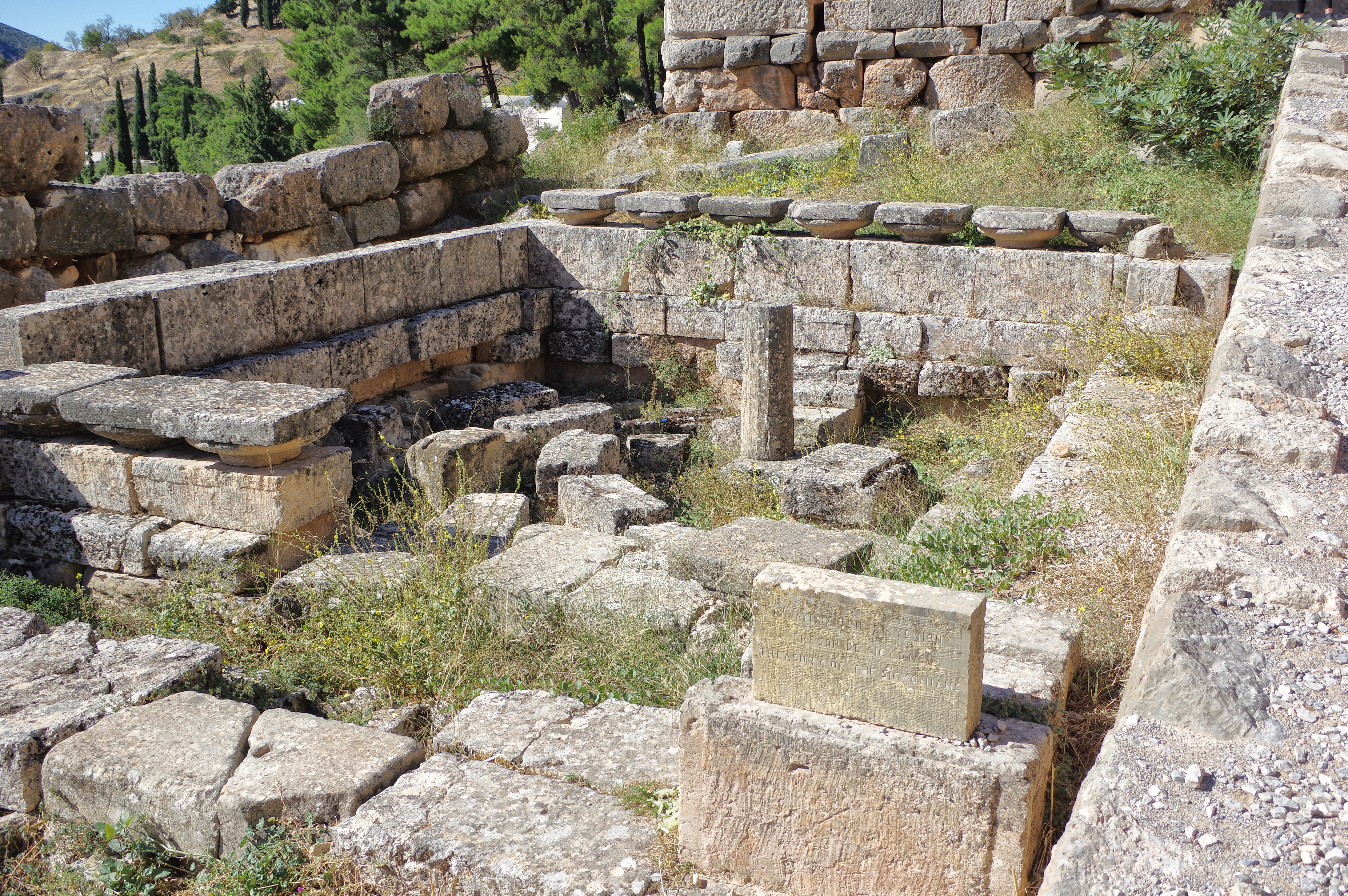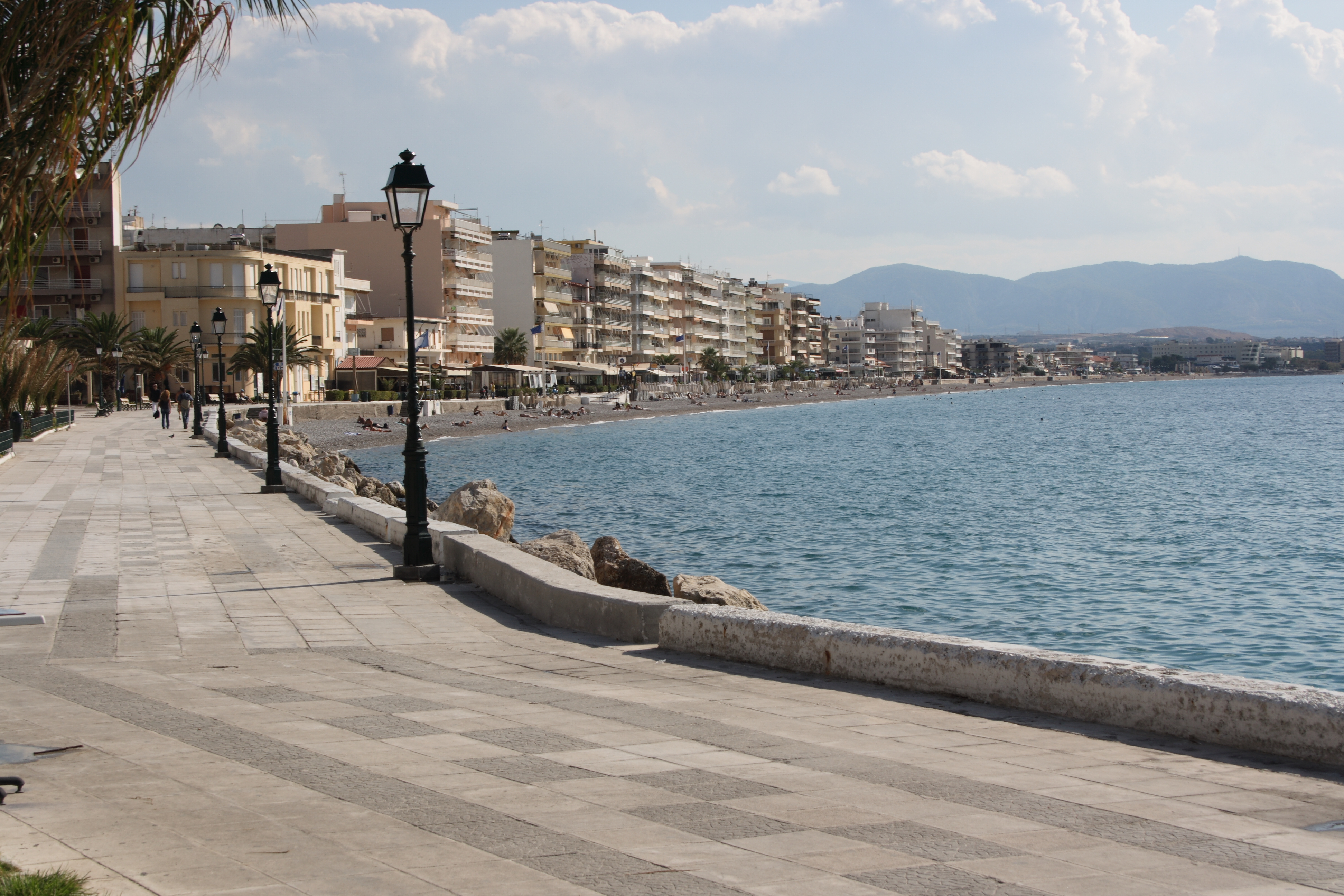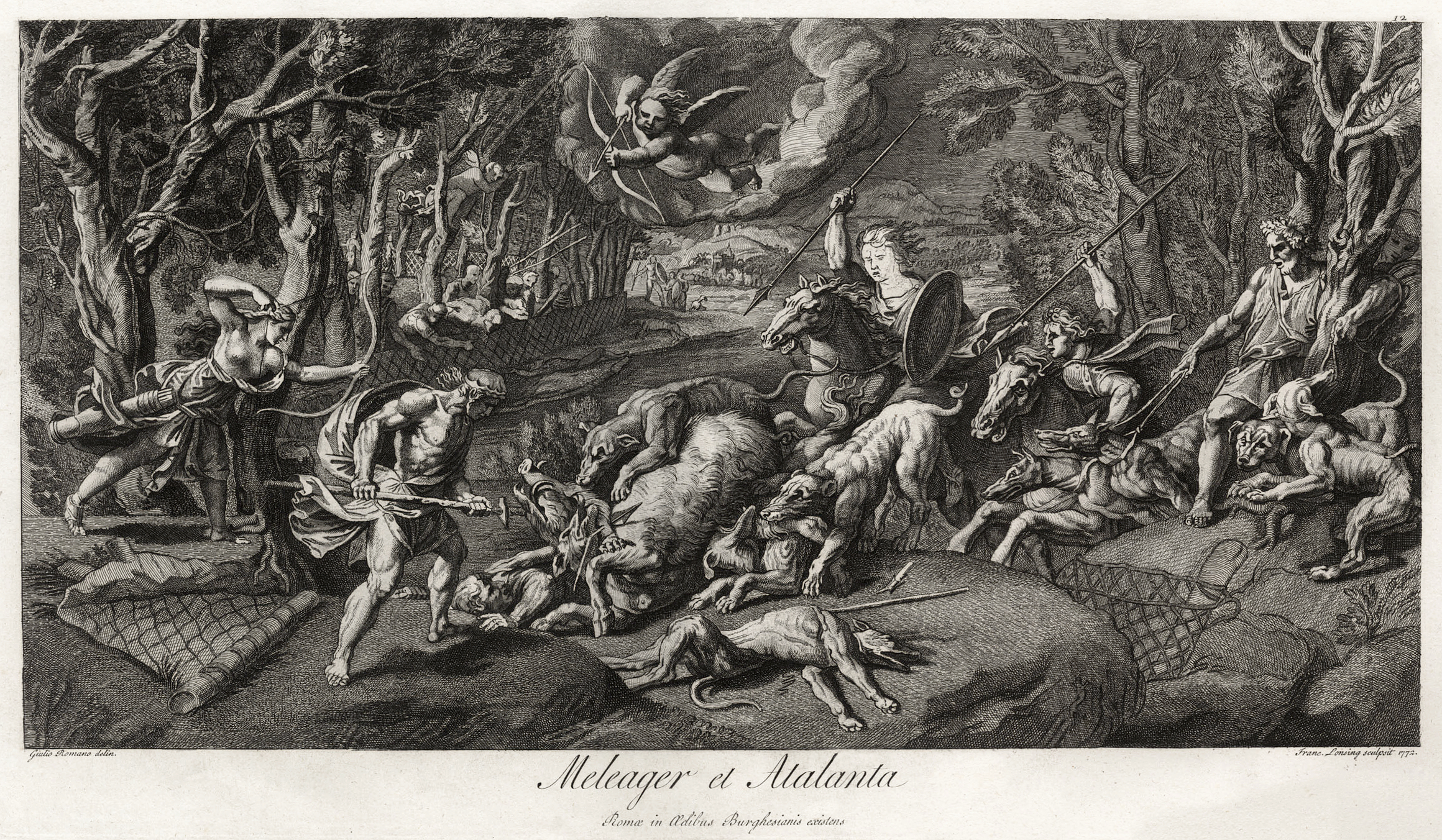|
Sicyonian Treasury
The Treasury of the Sicyonians is one of the buildings within the sanctuary of Apollo in Delphi. It has a long and complicated history. The treasury itself replaced two former buildings, namely the tholos and the monopteros, built by the same city at an earlier stage within the 6th century. The earlier buildings were related to the Orthagorids of Sicyon and particularly to the victories of the tyrant Cleisthenes of Sicyon in the course of the First Sacred War and their replacement probably marks the change in tide in Sicyonian politics. Description The Sicyonian Treasury is in fact a generic name, signifying three different buildings of the 6th century BC. The Tholos The Tholos of the Sicyonians was probably the oldest construction, dating to ca 580 BC, and built right after the First Sacred War at the instigation of the tyrant of Sicyon Cleisthenes, who was the most prominent leader in that war. It measured 6.3 meters at the base and 3.54 meters at the floor level and was su ... [...More Info...] [...Related Items...] OR: [Wikipedia] [Google] [Baidu] |
Delphi BW 2017-10-08 11-16-34
Delphi (; ), in legend previously called Pytho (Πυθώ), in ancient times was a sacred precinct that served as the seat of Pythia, the major oracle who was consulted about important decisions throughout the ancient classical world. The oracle had origins in prehistory and it became international in character and also fostered sentiments of Greek nationality, even though the nation of Greece was centuries away from realization. The ancient Greeks considered the centre of the world to be in Delphi, marked by the stone monument known as the omphalos (navel). The sacred precinct of Ge or Gaia was in the region of Phocis, but its management had been taken away from the Phocians, who were trying to extort money from its visitors, and had been placed in the hands of an amphictyony, or committee of persons chosen mainly from Central Greece. According to the Suda, Delphi took its name from the Delphyne, the she-serpent ('' drakaina'') who lived there and was killed by the god Apollo ... [...More Info...] [...Related Items...] OR: [Wikipedia] [Google] [Baidu] |
Helle (mythology)
Helle (; , Héllē), or Ellie, sometimes also called (), was a character in Greek mythology who figured prominently in the story of Jason and the Argonauts. Mythology Phrixus, son of King Athamas of Boeotia and the half-nymph Nephele, along with his twin sister, Helle, were hated by their stepmother, Ino. Ino hatched a devious plot to get rid of the twins, roasting all the town's crop seeds so they would not grow. The local farmers, frightened of famine, asked a nearby oracle for assistance. Ino bribed the men sent to the oracle to lie and tell the others that the oracle required the sacrifice of Phrixus. Before he was killed though, Phrixus and Helle were rescued by a flying golden ram sent by Nephele, their natural mother. Helle fell off the ram into the Hellespont (which was subsequently named after her) and either died or was rescued by Poseidon and turned into a sea-goddess, but Phrixus survived all the way to Colchis, where King Aeetes took him in and treated him kindly, g ... [...More Info...] [...Related Items...] OR: [Wikipedia] [Google] [Baidu] |
Theban Treasury (Delphi)
The Treasury of the Thebans at Delphi was built in the Doric order and made entirely out of local limestone from the quarries of St. Elias close to the town of Chrisso. It was situated a few meters below the first turn of the Sacred Way, the processional route in the sanctuary of Apollo. It had been dedicated by the Thebans for their victory against the Lacedaemonians at Leuctra (371 BC). Description Shortly after their victory against the Lacaedemonians at the Battle of Leuctra in 371 BC, a landmark of the brief Theban supremacy in the political life of Greece, the Thebans dedicated at the sanctuary of Apollo a treasury built in the Doric order. It was the largest treasury in dimensions of Delphi, situated close to the SW corner of the sanctuary. Rectangular in plan, measuring 12.29 by 7.21 meters, it stood on a crepis with two steps. It was constructed entirely out of local limestone from the quarries at St. Elias, a particularly hard stone with bluish-grey shades, which acc ... [...More Info...] [...Related Items...] OR: [Wikipedia] [Google] [Baidu] |
Cnidian Treasury
Cnidus was represented at the Sanctuary of Apollo in Delphi by the Treasury of the Cnidians of the late Archaic period and by a late Classical period building, called "Lesche", a kind of club for social gatherings. Description The remains of the Treasury of the Cnidians are situated just next to the Sacred Way close to the Siphnian Treasury to which they bear resemblance, to the exception of the smaller size. It was a marble building, erected before Cnidus was conquered by the Persians in 544 B.C. Its features remind of the mid-sixth century B.C. The treasury was built in the Ionian order, prostyle, but there is not much information on the exact plan of its elevation and the roof. It is possible that there were ''korae'' ( Caryatids) on the façade instead of plain columns. At the time of the Great Excavation it was thought that the friezes and sculpted decoration of the Siphnian Treasury actually originated from the Treasury of the Cnidians, a misinterpretation which led arch ... [...More Info...] [...Related Items...] OR: [Wikipedia] [Google] [Baidu] |
Boeotian Treasury
The Treasury of the Boeotians was dedicated in the late Archaic period within the sanctuary of Apollo at Delphi Delphi (; ), in legend previously called Pytho (Πυθώ), in ancient times was a sacred precinct that served as the seat of Pythia, the major oracle who was consulted about important decisions throughout the ancient classical world. The oracle .... It is identified due to some epigraphic material. Description Towards the southwestern end of the Sacred Way in the sanctuary of Apollo at Delphi are located the foundations of a treasury which is identified to that dedicated by the Boeotians. Pausanias does not mention this particular building, thus it is possible that it has been destroyed by his time. The architectural parts that are still extant indicate that it was a Doric building made of limestone on which inscriptions in the Boeotian writing style of the Late Archaic period have been preserved.E. Partida, “Two Boeotian Treasures at Delphi”, in Αραβαντ ... [...More Info...] [...Related Items...] OR: [Wikipedia] [Google] [Baidu] |
Athenian Treasury
The Athenian Treasury (Greek: Θησαυρός των Αθηναίων) at Delphi was constructed by the Athenians to house dedications and votive offerings made by their city and citizens to the sanctuary of Apollo. The entire treasury including its sculptural decoration is built of Parian marble. The date of construction is disputed, and scholarly opinions range from 510 to 480 BCE. It is located directly below the Temple of Apollo along the Sacred Way for all visitors to view the Athenian treasury on the way up to the sanctuary. Pausanias mentions the building in his account of the sanctuary, claiming that it was dedicated from the spoils of the Battle of Marathon, fought in 490 BCE against the Persians. The Battle of Marathon can be seen in some of the images of the metopes which compare their victory to mythology. By using the founder of Athens, Theseus, to show the victories of Athens, the treasury established Athens as one of the most powerful, polis, city-states of Greece ... [...More Info...] [...Related Items...] OR: [Wikipedia] [Google] [Baidu] |
Siphnian Treasury
The Siphnian Treasury was a building at the Ancient Greek cult centre of Delphi, erected to host the offerings of the polis, or city-state, of Siphnos. It was one of a number of treasuries lining the "Sacred Way", the processional route through the Sanctuary of Apollo, erected to win the favor of the gods and increase the prestige of the donor polis. It was one of the earlier surviving buildings of this type, and its date remains a matter for debate, with the most plausible date being around 525 BC. Until recently it was often confused or conflated with the neighbouring Cnidian Treasury, a similar but less elaborate building, as the remains of the two had become mixed together and earlier theoretical reconstructions used parts of both. The people of Siphnos had gained enormous wealth from their silver and gold mines in the Archaic period (Herodotus III.57) and used the tithe of their income to erect the treasury, the first religious structure made entirely out of marble. The buil ... [...More Info...] [...Related Items...] OR: [Wikipedia] [Google] [Baidu] |
Corinthia
Corinthia ( el, Κορινθία ''Korinthía'') is one of the regional units of Greece. It is part of the region of Peloponnese. It is situated around the city of Corinth, in the north-eastern part of the Peloponnese peninsula. Geography Corinthia borders on Achaea to the west and southwest, the Gulf of Corinth and Attica to the north, the Saronic Gulf to the east, Argolis to the south and Arcadia to the southwest. The Corinth Canal, carrying ship traffic between the Ionian and the Aegean seas, is about east of Corinth, cutting through the Isthmus of Corinth. Corinthia is increasingly seen as part of the wider metropolitan area of Athens, with municipalities, such as Agioi Theodoroi in the easternmost part of the regional unit, being considered suburbs of Athens. The area around Corinth and the western Saronic including the southeastern part are made up of fault lines including the Corinth Fault, the Poseidon Fault and a fault running from Perahcora to Agioi Theodoroi. M ... [...More Info...] [...Related Items...] OR: [Wikipedia] [Google] [Baidu] |
Distyle In Antis
In classical architecture, distyle in antis denotes a temple with the side walls extending to the front of the porch and terminating with two antae, the pediment being supported by two pilasters or sometimes caryatids. This is the earliest type of temple structure in the ancient Greek world. An example is the Siphnian Treasury in Delphi, built around 525 BCE. Smaller two-column structures without antae are called distyle. The next evolution in temple design came with amphiprostyle, where four columns stand in line on the porch in front of a naos. File:Treasury of the Siphnians by Hansen.JPG, Reconstruction of the Siphnian Treasury File:Greek temples.svg, Types of temple plan See also *Antae temple *Prostyle Prostyle is an architectural term designating temples (especially Greek and Roman) featuring a row of columns on the front. The term is often used as an adjective when referring to the portico of a classical building, which projects from the m ... References Anci ... [...More Info...] [...Related Items...] OR: [Wikipedia] [Google] [Baidu] |
Calydonian Boar
The Calydonian boar hunt is one of the great heroic adventures in Greek legend. It occurred in the generation prior to that of the Trojan War, and stands alongside the other great heroic adventure of that generation, the voyage of the Argonauts, which preceded it. The purpose of the hunt was to kill the Calydonian boar (also called the Aetolian boar), which had been sent by Artemis to ravage the region of Calydon in Aetolia, because its king Oeneus had failed to honour her in his rites to the gods. The hunters, led by the hero Meleager, included many of the foremost heroes of Greece. In most accounts, it also included a great heroine, Atalanta, who won its hide by first wounding it with an arrow. This outraged some of the men, leading to a tragic dispute. Importance in Greek mythology and art Since the Calydonian boar hunt drew together numerous heroes—among whom were many who were venerated as progenitors of their local ruling houses among tribal groups of Hellenes into Cla ... [...More Info...] [...Related Items...] OR: [Wikipedia] [Google] [Baidu] |
Zeus
Zeus or , , ; grc, Δῐός, ''Diós'', label=Genitive case, genitive Aeolic Greek, Boeotian Aeolic and Doric Greek#Laconian, Laconian grc-dor, Δεύς, Deús ; grc, Δέος, ''Déos'', label=Genitive case, genitive el, Δίας, ''Días'' () is the sky father, sky and thunder god in ancient Greek religion, who rules as king of the gods on Mount Olympus. His name is cognate with the first element of his ancient Roman religion, Roman interpretatio graeca, equivalent Jupiter (mythology), Jupiter.''Larousse Desk Reference Encyclopedia'', The Book People, Haydock, 1995, p. 215. His mythology and powers are similar, though not identical, to those of Indo-European deities such as Jupiter, Perkūnas, Perun, Indra, Dyaus, and Zojz (deity), Zojz. Entry: "Dyaus" Zeus is the child of Cronus and Rhea (mythology), Rhea, the youngest of his siblings to be born, though sometimes reckoned the eldest as the others required disgorging from Cronus's stomach. In most traditions, he is m ... [...More Info...] [...Related Items...] OR: [Wikipedia] [Google] [Baidu] |

.jpg)
.jpg)
.jpg)


